#emaki
Text

The landscape of one of the three shrines of Kumano, a detail from "Illustrated Legends of the Origins of the Kumano Shrines" (熊野縁起絵巻), a set of handscrolls dating to the late 16th or early 17th century
El paisaje de uno de los tres santuarios de Kumano, un detalle de "Leyendas ilustradas sobre los orígenes de los santuarios de Kumano" (熊野縁起絵巻), un conjunto de pergaminos que datan de finales del siglo XVI o principios del siglo XVII
Image from the collection of the Metropolitan Museum of Art in New York
#japanese art#japanese literature#arte japonés#literatura japonesa#japanese religion#religión japonesa#絵巻#emaki#熊野三山#kumano sanzan#illuminated manuscript#manuscrito iluminado#熊野縁起絵巻#kumano engi emaki#鳥居#torii
26 notes
·
View notes
Text
Five Yōkai references to Studio Ghibli films
An avid lover and aficionado of Studio Ghibli’s work, I see references to and from it practically everywhere. Most recently at an exhibition about yōkai.
Yōkai are a class of supernatural creatures that roam the realm of spirits in Japanese folklore. The Japan Foundation organised traveling exhibition titled “Yōkai: Supernatural Monsters from Japan” introduces these curious spirits through a diverse range of media, including nishiki-e prints, emaki picture scrolls, sculptures, toys and films.
Apart from the harmonious and subtle color palettes, the lush and peculiar imagination of the ancient artist, his experienced hand drawing each brush stroke, and the excitement of seeing a picture scroll in real life, what really intrigued me were the images that looked like a scene from a Studio Ghibli film. Listed below are some of the references I spotted.
1.Mount Ōe Picture Scroll and Princess Mononoke
First in line was this one illustrating the heroic tale of the brave samurai Minamoto no Yorimitsu, who, according to legend, exterminated the quintessential yōkai Shuten-dōji, a mythical oni or demon leader of Japan. Although decapitated, the demon’s detached head still took a bite at the hero, who avoided death by wearing multiple helmets stacked on his head.
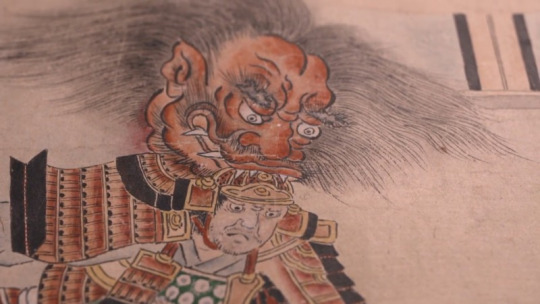
Close-up of Shuten-doji biting at his decapitator. Source: The Japan Foundation
In Princess Mononoke, on a few occasions Lady Eboshi warns her people that it will take more than a single shot to kill a wolf god: “A wolf’s severed head can still bite.” Ignoring Ashitaka’s warning and attempt to stop her from committing yet another godslaughter, Eboshi succeeds in murdering the Forest Spirit. This victory is short-lived, however, as soon after Eboshi gets her well-deserved punishment for angering the gods when the wolf god Moro’s decapitated head bites off her right arm: “Moro’s head. It moved on its own,” feels like Eboshi had foreshadowed her own misfortune.

Wolf god Moro’s decapitated head after she mutilated Lady Eboshi. © Studio Ghibli
2.The Night Parade of One Hundred Demons Picture Scroll and
Howl’s Moving Castle
This is more of a visual than content resemblance. The big headed tengu and courtesan riding the cart instantly reminded me of the Witch of the Waste’s disproportionate head when she is similarly looking through the window of her palanquin carried around the city by her loyal henchmen.
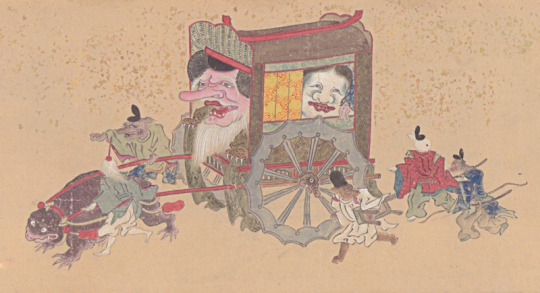
Tengu and courtesan riding a cart pulled by a toad. Source: The Japan Foundation

Close-up of the Witch of the Waste. © Studio Ghibli
3.The Nue and Princess Mononoke’s Forest Spirit
If you have ever leafed through The Art of Princess Mononoke book you might know that the Forest Spirit (shishigami) didn’t always have that same soothing smile and piercing eyes that are both amicable and cruel. In the early stages of his development his face was more human-like and uncanny than it is now. Though at first glance he resembles a deer, the Forest Spirit is actually a combination of several animals. This blog post lists them as follows: a red-monkey face covered with blue patterns, cat eyes and nose, goat ears, big body of a wild boar, the fur of a serow, and the tail of a dog. As a whole his appearance is one overflowing with peculiarity.

The Forest Spirit preying on a Shinto tree branch. © Studio Ghibli
Similarly the Nue, a legendary yōkai or mononoke, in The Tale of the Heike, is described as having the head of a monkey, the legs of a tiger, the body of a dog and the front half of a snake for a tail. In other writings it is sometimes depicted to have the back of a tiger, the legs of a tanuki, the tail of a fox, the head of a cat, and the torso of a chicken.
The Nue is also said to have the ability to shape-shift, often into the form of a black cloud that can fly. Much like the Forest Spirit who at nightfall changes to the giant Nightwalker (deidarabotchi).
Another similarity worth mentioning is that in both cases the mythical creature is indirectly murdered by the Japanese emperor. Lady Eboshi intends to give the Forest Spirit’s head, which is believed to grant immortality, to the Emperor in return for protection from Lord Asano. In The Tale of Heike, the samurai Minamoto no Yorimasa slays the Nue, because its very existence causes fear in the Emperor who falls ill and is unable to recuperate.

Minamoto no Yorimasa defeats the mythical beast Nue. Source: The Japan Foundation
4.The Foot Washing Mansion and Spirited Away
This nishiki-e print depicts a large-footed yōkai monster that descends from the ceiling and demands to be washed. The story is one of seven stories in the famous Seven Wonders of Honjo and goes as follows: At the time when the flowers were sleeping and the ushimitsu plant was blooming, a horrible, rotten stench would invade the house, and a giant foot bristling with hair would descend from the ceiling accompanied by an enormous sound. If you washed the foot, it would soon disappear back into the ceiling. But if you didn’t, the giant foot would rampage through the house until satisfied.

The large-footed yōkai descending from the ceiling. Source: The Japan Foundation
Most of Spirited Away’s plot takes place within a bathhouse for gods and spirits, known as kami, whose proprietor is the greedy witch Yubaba. The majority of these kami habitually visit the bathhouse for a regular wash to keep themselves clean — unlike the unwelcome enormous and foul smelling guest who imposes his presence and causes turmoil. He smells so bad that at first everybody, unsuccessfully, tries to prevent him from entering the bathhouse. Eventually they realise he is harmless — only after Chihiro cleanses him and sets him free from the taint of humanity.

A kami being washed at Yubaba’s bathhouse. © Studio Ghibli
5.Personified Daikon Radish and Spirited Away’s Oshirasama
According to Japanese ideas of animism, spirit-like entities are believed to reside in all things, both the living and the dead, including natural phenomena and objects. Kami and yōkai inhabit the spirit domain and in shape or nature can be either humans, animals, plants, natural phenomena or artifacts. Like for example this daikon radish (can you spot it?) appearing on omocha-e play pictures made for children’s entertainment as early as the Meiji era (1868–1912).
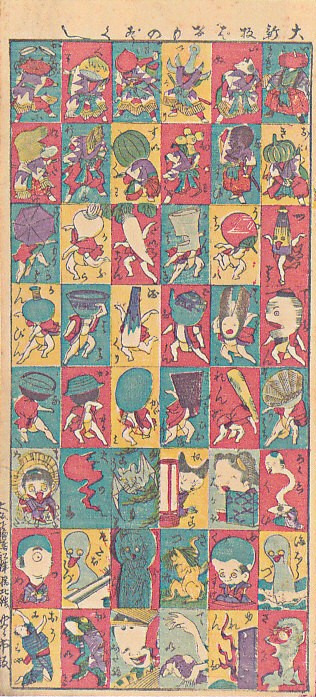
Yōkai-themed omocha-e. Source: The Japan Foundation
Root vegetables like radishes and carrots have often become internet sensations due to the occasional deformations they suffer. Their wonky shapes might have displeased a farmer in the past and ended up in the garbage instead of as pickles. Similar destiny had already befallen the objects of a house possessed by spirits. Discarded while the house was being exorcised, the aggrieved objects transform into yōkai and start plotting their revenge.
Oshirasama (Radish Spirit or Great White Lord) is the white, hefty, slow-moving guest at Yubaba’s bathhouse who resembles a radish sumo wrestler. His name, Oshirasama, is also the name of a kami of agriculture in the Shinto faith.

Radish Spirit riding the elevator alongside Chihiro. © Studio Ghibli
Have you noticed any of these? Do you perhaps know of another reference I might have missed out. How about re-watching the above mentioned films with this newly gained perspective?
Japanese folklore is rich, extraordinarily original and beautiful. And so are Studio Ghibli’s films.
Source
#studio ghibli#ghibli films#hayao mizayaki#spirited away#princess mononoke#howl's moving castle#yokai#japan foundation#yōkai: supernatural monsters from japan#emaki#nishiki-e
98 notes
·
View notes
Text
commission a handscroll artist to paint a scene from your favorite story
#heian japan#heian period japan#heian era#heian period#emaki#taking fangirling to a new level#wonder how big the fanart market was
18 notes
·
View notes
Text

Following the pumpkin ghost figurine I reposted awhile ago, here is another adorable beast handmade by youkai-enthousiast artist Acotama.
Acotama's work is inspired by characters drawn in hyakki yagyo emaki (scrolls depicting "night parades of one hundred demons") popular during Edo-period. If some monsters were well known ones (kitsune, tengu, oni, kappa, etc.), many only appear once, making them cheeky creepers drawn for fun more than terrifying creatures of the night.
The discarded hakama shown here is awakening into a tsukumogami with a funny fox-deer face:
#japan#art#craft#figurine#sculpture#youkai#monster#hyakki yagyo emaki#night parades of one hundred demons#hyakki yagyo#Acotama#tsukumogami
235 notes
·
View notes
Text
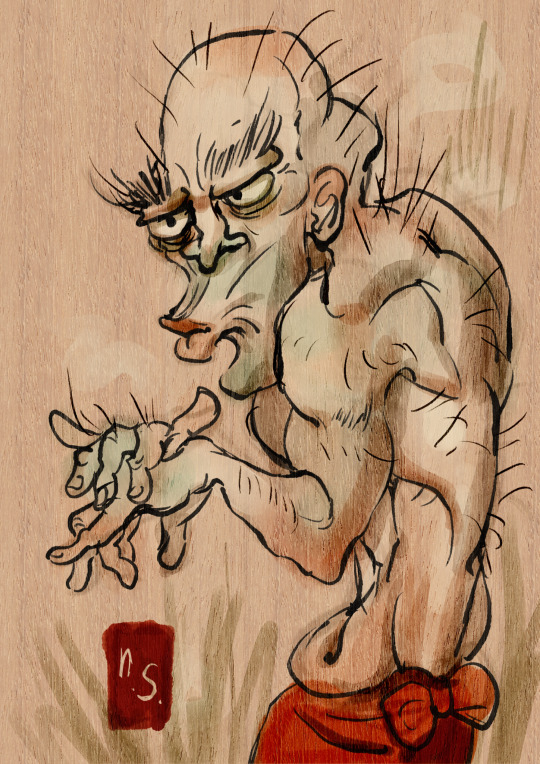
Minokedachi, yes it's a yokai. It's a manifestation of hair a raising experience. Who or what it truly is, may only be known to the artist(s) of Yokai Emaki Zukushi.
I really do hope this is not just some random guy the artist doesn't like and decided to immortalize as a lumpy, suspicious, looking, Yokai.
38 notes
·
View notes
Text
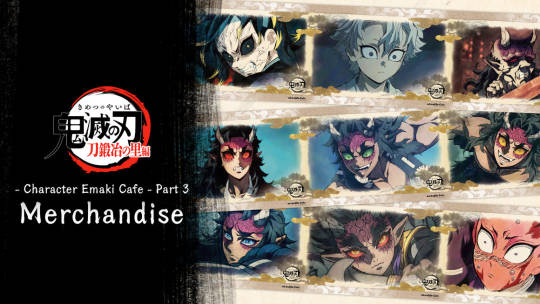
The emaki cafe merch is available on the Global Webshop !
【Pre-order Date 2024/2/1 18:00~2024/2/16 23:59(JST) 】
#demon slayer#emaki cafe#hantengu#hantengu clone#hantengu clones#karaku#aizetsu#sekido#urogi#zohakuten#kny#kimetsu no yaiba#genya
11 notes
·
View notes
Text


Demon Love Spell Vol 3
#demon love spell#Ayakashi Koi Emaki#Mayu Shinjo#Miko Tsubaki#Kagura#comedy#romance#paranormal#demons#manga
3 notes
·
View notes
Text
ok but did you know that hana to mai tori to utai kazu wo yomi tsuki wo medete hoshi to mai niji to utai toki wo yomi yume wo mede-
#WA NI NATTE!!! SAA MAI ODERE!!!!!#i remembered matsuriyo emaki existed gimme a minute#akatsuki#enstars
14 notes
·
View notes
Text

An itinerant monk being guided through the underworld: A scene from the "Illustrated Legends of the Kitano Tenjin Shrine" (北野天神縁起絵巻) dating to the late 13th century
Set of five handscrolls with ink, color, and cut gold on paper from the collection of the Metropolitan Museum of Art in New York
#japanese art#illuminated manuscript#japanese literature#buddhist literature#絵巻#emaki#縁起#engi#北野天神縁起絵巻#kitano temjin engi emaki#arte japonés#literatura japonesa#manuscrito iluminado
35 notes
·
View notes
Text
I miss singing with Robin and Dino but I feel like my voice has been dead for months...
#utter rambling#or at least I hate listening to it currently...#minus that one day a while back that I managed to do matsuriyo emaki#i miss the summer maaaaaaan#give me free time I want to vibe and do things I like
4 notes
·
View notes
Text
yoshitaka amano`s illustrations of the tale of genji are driving me insane
#hwæt#they`re sooooo close to what i imagine onna-e emaki looking like back before they were so severely faded
2 notes
·
View notes
Text
Why did Japanese Manga highly develop? Because Japanese are very sloppy religiously.(Essay)

A stinky monkey worshiping a frog impersonating Buddha (Choju-Giga)
The following is an exchange of comment between my blog friend cenecio and me (iirei) about manga.
cenecio: Mr. Morishita, I would like to ask you, why did the field of manga develop in Japan?
This is a question from Mr. Gear and me. Thank you. If you have time, it doesn't matter tomorrow.
iirei: This is a very difficult question. Speaking of my past logs, there is one that deals with bird and beast caricatures,so called”Choju-Giga(鳥獣戯画)”.
We recognize that this picture scroll is one of the oldest manga in Japan. When writing this blog, Isao Takahata clearly saw "frame splitting" about "Shigisan Engi Emaki", and he also referred to the book "Japanese Animation" (was it), which was said to be a pioneer of manga. He made it.
Returning to Choju-Giga, as a famous scene like sumo wrestling of frogs and rabbits, it is especially remarkable in the picture of a fishy monkey shaved worshiping the principal image of a frog, but in other countries the religious main god is likened to a frog. It’s impossible.
Religion is still not really rooted in Japan. But what should be noted here is the idea of parody. The combination of frogs and monkeys is a wonderful parody. These picture scrolls were made from the end of the Heian period to the beginning of Kamakura period, with a religious background in which "Pure Land Buddhism" covered Japan, but the Japanese are sloppy(Charanporan), aren't they? While admiring the Pure Land, he makes fun of it. Of course, Western European countries also had parodies like Rabelais did, but I think they weren't as non-religious as Japan.
I think that this comment alone is not enough to answer this difficult question. If you come up with something again, I'll write it.

Note: Mr. Takahata(Member of Studio Gibli)’s book, official name "Animation of the 12th Century: Movie-like and Anime-like Things Seen in National Treasure Picture Scrolls" (Tokuma Shoten: 1999).
…………………………………………..
cenecio: Good morning, Mr. Morishita.
I'm sorry to hear from you last night.
> Isao Takahata clearly sees "frame splitting" about "Shigisan Engi Emaki", and this picture scroll is also a pioneer of manga.
This is interesting. How to divide the frames is a big difference between manga and BD, and it seems to be one of the themes that the discussion is enthusiastic about.
I would like to find out about the roots of manga myself.
Thank you very much.
The situation changes depending on where you take the manga overrun (Ransho: 濫觴:the time of the headwaters). I think it is generally from Osamu Tezuka, but there is also a position that it is from Suiho Tagawa's "Norakuro". In my case, I made the argument based on the Heian period bird and beast caricature and Shigisan Engi Emaki(picture Scrolls).
A word of the day: In addition, the representative of the story manga was Osamu Tezuka, and the representative of the gag manga was Fujio Akatsuka. (The Tezuka Award and Akatsuka Award are the gateways for young manga artists in Japan to be held by Shueisha.) Regarding this extremely interesting work, especially "Tensai Bakabon(The genius fool)" the manga artist was not Charamporan(sloppy), but the reader was Charampolan. The creators of gag manga are those who draw their works with bloody efforts, and story manga does not require much tension. In fact, the lifespan of a gag manga artist as an author is shorter than that of a story manga artist.
After the serialization of Tensai Bakabon, Mr. Akatsuka serialized a manga called "B.C. Adam" that "teases" the Bible. I remember that this work was not very popular, but I think it was rather a work that showed Mr. Akatsuka's own charamporan.
#manga#Ja;an#sloppy#charamporan#Choju-Giga#Isao Takahata#frame splitting#Shigisan Engi Emaki#religion#parody#animation#Studio Gibli#Fujio Akatsuka#Tensai Bakabon#essay#Babylman
5 notes
·
View notes
Text
matsuriyo emaki.... matsuriyo emaki
0 notes
Text
.
#omg do u ever do smn. and it gets posted publicly AND YOU HATE IT.#and you actively avoid it but then you actually go back and give it a chance and it actually. isnt as bad as u rmr.#me with the tenshiprojectM yt uploads im in ALKSDJ#like SURE i fucked up and didnt do my nazuna voice properly (sobs sorry nazuna ily) but it wasnt wronnnngggg...?#like my sweet sweet white song part wasnt WRONG.. but its not nazuna. and i struggled w that shit for so long ASKDLJS it came out cute tho#and Aisle Be With You. i was having mic problems so i settled with whatever in a rush.#And it also turned out very not Nazuna sounding.. But like its not wrong?#mic quality differences making me cringe tho#eW THE MIC QUALITY IN JOYFUL BOX. I THINK I WAS SICK WHILE RECORDING TOO EWWW#... but AGAIN. its not WRONG..... ><#aw my duet w aria and fallin love = its wonderland isnt on youtube :( only twt..#tbh thankfully my groupmates r really thorough ALSKDJ if im wrong they say so asap LMAO#and thank them for that fr fr bc this shit always gets posted on yt </3#44597#OMG FUCKIN TMI BUT I RMR THE FIRST RECORDING. EVERYONE ELSE GOT TO ACT CUTE. BUT THEY TOLD ME NOT TO LMAOO#BC I COULD ONLY GET THE “NAZUNA SOUND” OUT OF MY VOICE IF I SANG LOW NORMALLY. LMAOOOOO#it was so unfair </3 so now i sound uncute in every recording when we are a CUTE GROUP. THE OTHER 3 R SOOOO CUTE.#MATSURIYO EMAKI. I REDID THAT SHIT LIKE 4 TIMES BC I KEPT FUCKING UP SOMETHING UP. DIFF THING EVERY REDO. SO ANNOYINGGGG#it was my last line i think. so annoying it kept sounding cute or flat i just fucking gave up#oUGHGH AND FUCKING NOIR NEIGE... BANGER LINEUP. what the FUCK was i doing there!#KUUKI AND BASIL CENTERS? HOLY SHIT? TALENTED AS FUCK NATTO AND ASTE?#i fuckin love natto btw and lowkey got like. singing crush on basil and kuuki hoooooly fuck#I DIDNT EVEN KNOW IT WAS THEM UNTIL THE VID WENT UP#i was just like “ayo that guy sounds good who tf is that (doesnt recognize his user)” BASIL. IT WAS BASIL.#so uPSET I DIDNT REALIZE. I RECORDED WHILE SICK AND USING THE SHITTY MIC. bc i just had like 1 line and i had another noir neige to record#sobs
1 note
·
View note
Text
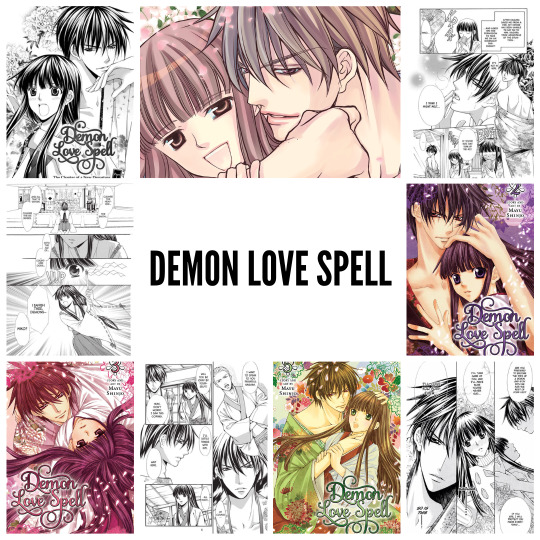
Demon Love Spell
6 volumes.
Licensed by Viz Media.
Miko is a shrine maiden who has never had much success at seeing or banishing spirits. Then she meets Kagura, a sexy demon who feeds off women's feelings of passion and love. Kagura's insatiable appetite has left many girls at school brokenhearted, so Miko casts a spell to seal his powers. Surprisingly, the spell works - sort of - but now Kagura is after her!
Status in Country of Origin
6 Volumes (Complete)
Tags:
Apprentice/s
Bickering Love
Exorcism
Ghost/s
Human-Nonhuman Relationship
Kiss-Based Powers
Live-in Lover
Lust
Magic
Possessive Lover/s
Sealed Power
Shrine/s
Spirit/s
Tsundere
#Demon Love Spell#Ayakashi Koi Emaki#SHINJO Mayu#comedy#romance#shoujo#smut#supernatural#shojo beat#viz media#Margaret#shueisha#2008#2000s#manga#completed
0 notes
Text
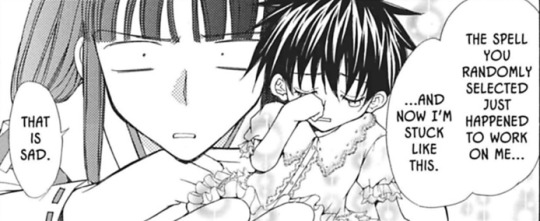
Demon Love Spell Vol 1
#manga(visual)monday#demon love spell#ayakashi koi emaki#mayu shinjo#miko tsubaki#kagura#comedy#romance#manga
2 notes
·
View notes